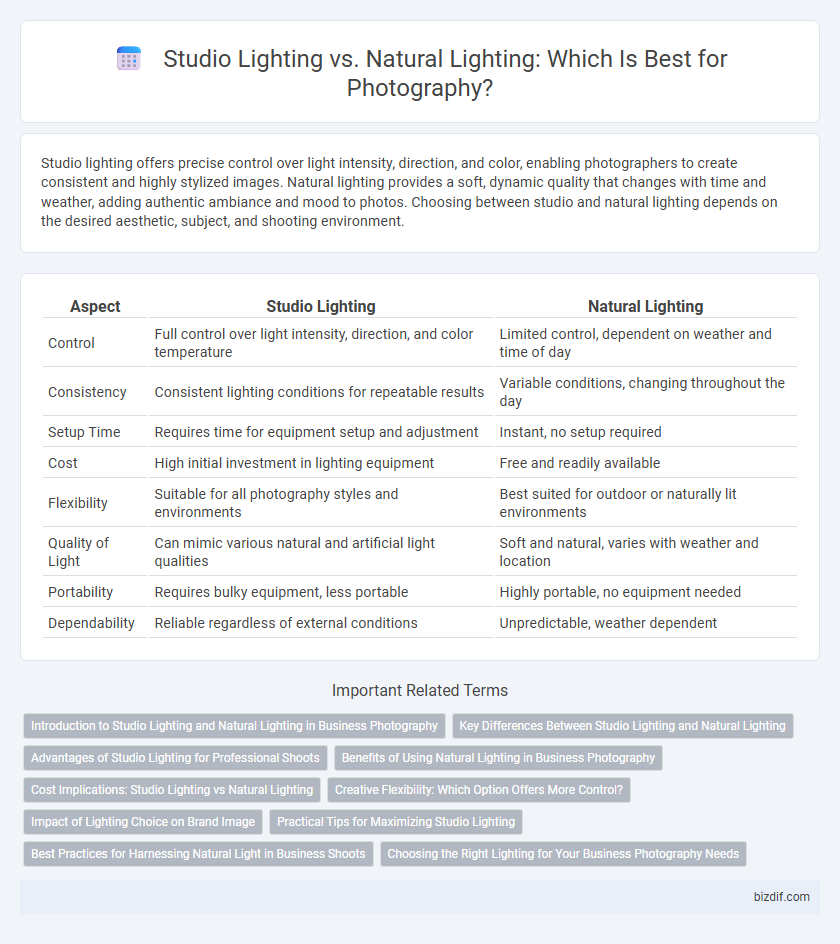Studio lighting offers precise control over light intensity, direction, and color, enabling photographers to create consistent and highly stylized images. Natural lighting provides a soft, dynamic quality that changes with time and weather, adding authentic ambiance and mood to photos. Choosing between studio and natural lighting depends on the desired aesthetic, subject, and shooting environment.
Table of Comparison
| Aspect | Studio Lighting | Natural Lighting |
|---|---|---|
| Control | Full control over light intensity, direction, and color temperature | Limited control, dependent on weather and time of day |
| Consistency | Consistent lighting conditions for repeatable results | Variable conditions, changing throughout the day |
| Setup Time | Requires time for equipment setup and adjustment | Instant, no setup required |
| Cost | High initial investment in lighting equipment | Free and readily available |
| Flexibility | Suitable for all photography styles and environments | Best suited for outdoor or naturally lit environments |
| Quality of Light | Can mimic various natural and artificial light qualities | Soft and natural, varies with weather and location |
| Portability | Requires bulky equipment, less portable | Highly portable, no equipment needed |
| Dependability | Reliable regardless of external conditions | Unpredictable, weather dependent |
Introduction to Studio Lighting and Natural Lighting in Business Photography
Studio lighting in business photography offers precise control over light intensity, direction, and color temperature, ensuring consistent image quality regardless of external conditions. Natural lighting relies on ambient sunlight, providing a softer and more dynamic look but requiring careful timing and location selection to avoid shadows or uneven exposure. Understanding the advantages of studio lighting, such as repeatability and customization, versus the organic feel of natural lighting helps businesses create professional and visually compelling images tailored to their brand identity.
Key Differences Between Studio Lighting and Natural Lighting
Studio lighting offers precise control over intensity, direction, and color temperature, enabling consistent results regardless of environmental conditions. Natural lighting varies with time of day and weather, producing softer, more dynamic shadows that can enhance the atmosphere but reduce predictability. Photographers often choose studio lighting for commercial shoots requiring uniformity, while natural lighting suits outdoor portraits and artistic applications valuing organic ambiance.
Advantages of Studio Lighting for Professional Shoots
Studio lighting offers consistent and controllable illumination, allowing photographers to precisely shape shadows and highlights for professional shoots. It enables the use of various modifiers such as softboxes, umbrellas, and grids to achieve desired effects and maintain color accuracy. This control over lighting conditions ensures high-quality, reproducible results regardless of external weather or time of day.
Benefits of Using Natural Lighting in Business Photography
Natural lighting enhances business photography by creating a soft, authentic ambiance that highlights true colors and textures without the harshness of artificial sources. This cost-effective solution reduces the need for expensive equipment and setup time, allowing for more spontaneous and dynamic shoots. Furthermore, natural light boosts the mood and engagement of subjects, resulting in more genuine expressions and professional images.
Cost Implications: Studio Lighting vs Natural Lighting
Studio lighting requires significant upfront investment in equipment such as softboxes, strobes, and light meters, averaging $1,000 to $5,000 for professional setups, but offers consistent control and versatility. Natural lighting incurs minimal costs, relying primarily on location and timing, making it a budget-friendly option for photographers. Operational expenses like electricity and maintenance further increase studio lighting costs, while natural light is inherently free and environmentally sustainable.
Creative Flexibility: Which Option Offers More Control?
Studio lighting offers unparalleled creative flexibility by allowing precise control over light intensity, direction, and color temperature, enabling photographers to tailor the mood and atmosphere of each shot. Natural lighting, while dynamic and often softer, is subject to environmental variables such as time of day and weather, limiting consistent control over exposure and shadows. For projects demanding exact light manipulation and repeatability, studio lighting provides a superior level of control that fosters innovative artistic expression.
Impact of Lighting Choice on Brand Image
Studio lighting offers precise control over shadows, highlights, and color temperature, allowing brands to create consistent and polished images that reinforce professionalism and reliability. Natural lighting provides a soft, authentic ambiance that enhances brand authenticity and approachability, appealing to audiences seeking genuine and relatable visuals. Selecting the appropriate lighting type significantly influences brand perception, shaping consumer trust and emotional connection through visual storytelling.
Practical Tips for Maximizing Studio Lighting
Maximizing studio lighting involves controlling light direction, intensity, and diffusion to create a balanced and flattering subject illumination. Use softboxes or umbrellas to soften shadows and avoid harsh highlights, while adjusting the distance and angle of lights to shape textures and contours effectively. Incorporate reflectors and flags to manage light spill and enhance contrast, ensuring precise control over the final image quality.
Best Practices for Harnessing Natural Light in Business Shoots
Maximize natural light in business shoots by positioning subjects near large windows or open doors to create soft, even illumination that enhances facial features and product details. Use reflectors or white surfaces to bounce light and reduce harsh shadows, ensuring a professional and flattering appearance. Shoot during golden hours--early morning or late afternoon--for warm, diffused light that adds a polished and approachable tone to corporate portraits and commercial imagery.
Choosing the Right Lighting for Your Business Photography Needs
Studio lighting offers precise control over intensity, direction, and color temperature, essential for producing consistent, high-quality images in professional business photography. Natural lighting, favored for its soft, flattering tones and cost-efficiency, requires careful scheduling and location scouting to optimize results. Selecting the appropriate lighting depends on the specific demands of the business shoot, balancing flexibility, budget, and desired visual impact.
Studio Lighting vs Natural Lighting Infographic

 bizdif.com
bizdif.com